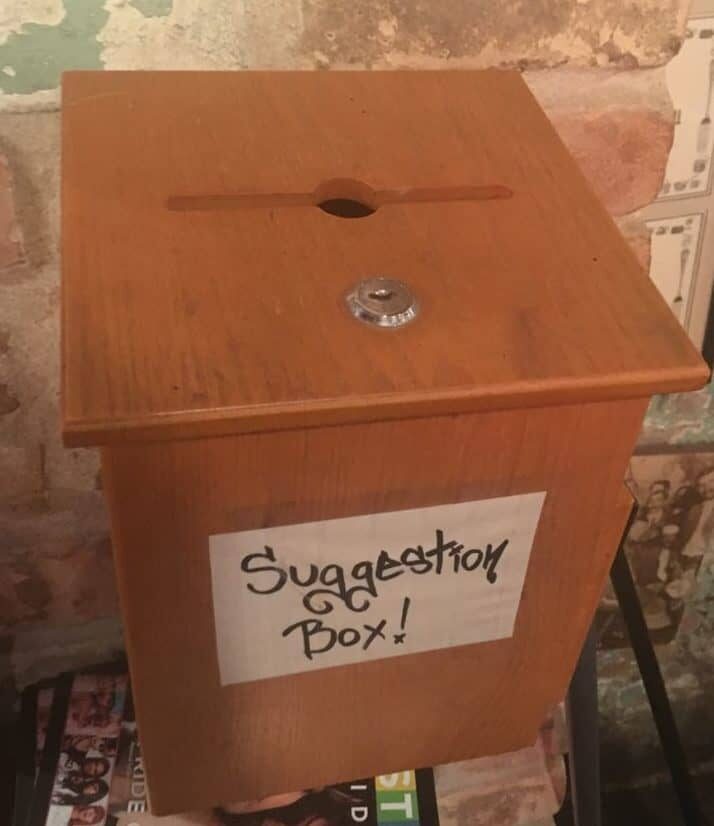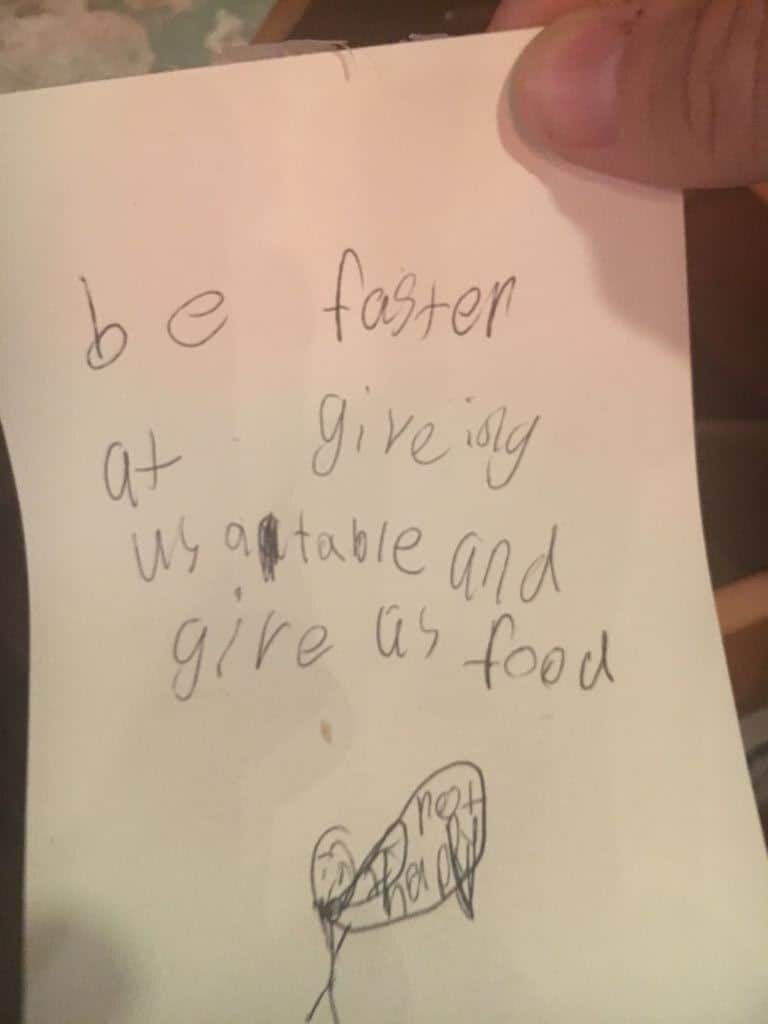Last week, I was in Austin for the annual Lean Coaching Summit, where I took a full-day class on “Motivational Interviewing” (as I had previewed here) and talking with a lot of great folks (familiar faces and new connections).
A group of us, including friends and previous podcast guests Mike Orzen, Karyn Ross, joined me, some other folks, and future podcast guests Tracey and Ernie Richardson (their new book, The Toyota Engagement Equation, is out soon).
After dinner, I walked past the suggestion box that was posted just inside the front door.
One of my dinner companions goaded me into taking a closer look (it could have been the margarita talking). Here is that box… they said, “Look, there's a lock on it,” knowing that I often playfully mock the need to lock a workplace suggestion box, including here.
It's funny to me that there's an exclamation point “Suggestion Box!” as if to imply this is exciting.
Somewhat surprisingly, the box was actually unlocked. Yes, I tried opening it (that might have been the margarita acting). It might have been rude and not my place, but I took a peek.
Sure enough, there were MANY slips of paper. It begs the question of how long those pieces of paper had been in there. Was this where “good ideas go to die?”
I don't remember the restaurant offering slips of paper, so it seemed that, if you wanted to put in a suggestion, you had to be pretty motivated.
I was about to just close the box, but what appeared to be a child's handwriting jumped out at me. Again, maybe I shouldn't have, but I took a closer look:
The child (or somebody in their party) was clearly “not happy” (or somebody goaded them into writing this).
This wasn't a “suggestion” slip, it was a complaint.
The service was too slow, apparently. Too long of a wait for a table. Too long of a wait for food.
Maybe they also waited too long for a server to appear.
There's no “suggestion” here other than the implied “fix it.”
In the history of suggestion boxes, they are often well intended. Sadly, more often than not, these boxes end up being very demoralizing when the intent is workplace improvements.
Worse than not asking for suggestions is asking for suggestions and then doing nothing with them.
There are so many reasons why the classic “suggestion box” system just doesn't work, as I've tried to address in Healthcare Kaizen and other settings, including:
This video:
This webinar:
And these blog posts:
When Will The Federal Government & VA Learn? On Suggestion Boxes & Incentives
Suggestion Boxes are Disliked & Ineffective Around the World
The Kaizen methodology provides a clear alternative that has a fighting chance of succeeding, if leaders put effort into create an environment in which people can speak up, suggest changes, and test those changes to see if they are improvements.
I had a really good experience at the restaurant last week. My suggestions to them include:
- Open up the box and read the comments
- Take action, when possible, based on the customer ideas
- Engage restaurant employees in improving products, processes and systems, in response to customer suggestions
- Engage every employee in helping drive improvements driven by frustrations in their own work, making work easier so they can provide better service to customers and better profits to the restaurant's bottom line.
What do you think?
You can also see some restaurant related posts on Kaizen (or the lack thereof):
Why and How This Pizza Restaurant Owner Engages People Through Kaizen
Coffee Shop Kaizen: Why Every Mug Doesn't Need a Spoon (Every Customer is Unique!)
Thanks for reading!
What do you think? Please scroll down (or click) to post a comment. Or please share the post with your thoughts on LinkedIn – and follow me or connect with me there.
Did you like this post? Make sure you don't miss a post or podcast — Subscribe to get notified about posts via email daily or weekly.
Check out my latest book, The Mistakes That Make Us: Cultivating a Culture of Learning and Innovation:













Interesting post! I agree 100% that you need to have a review process and get employees involved; otherwise, what’s the point? I wrote an article on LinkedIn a couple months back about a similar challenge and our solution to it. When trying to tap into employee creativity (i.e. creating an suggestion system for employees only), having a visual system such as a 4′ x 8′ cork board, works well. When placed in a common area, it allows everyone to see the current status of each idea. Either it’s a new idea, it’s been reviewed and in the process of being implemented, or it’s been completed and communicated to all. Now when trying to get ideas from customers, perhaps a box by the door or a survey with the bill would be best. It’s all about continuous improvement so if one system doesn’t work, make changes to improve it! Thanks for sharing Mark!
Thanks, David. Can you share a link to your article?
I think the appropriate use of a suggestion box is when it is collecting customer input. Norm Bodek taught me that suggestions are something that “U” can do (since there’s a U in suggestion).
He taught me to use the word “Ideas” with employees, because it starts with “I” and we’re helping employees find things “I can do.”
Yes, there’s an “i” in “suggestion.”
I’m a big fan of the cork board you describe to create visibility, whether we call it a “Kaizen Board” or an “Idea Board.”
I share that methodology and examples in our Healthcare Kaizen books.
Visibility can also be provided via web-based systems.
Regardless of the technology used, it’s absolutely critical to have a solid methodology and the right leadership behaviors.
You could make a suggestion box system work if you really put your mind to it, but there are many other conceptual differences between “Kaizen” and suggestion boxes. I’d just as well make things visual and visible… and why NOT do that with customer feedback?
Here’s the link to the article: https://www.linkedin.com/pulse/power-idea-board-david-battel?published=t
Interesting point with the ideas for employees and suggestions for customers. I never thought of it that way but that makes a lot of sense!
Regardless of whether you have/can afford a high tech idea/suggestion system, you have to have the fundamentals down. No sense in investing time and effort into a computerized system if the responses won’t be addressed!
Yes, we believe that very strongly at KaiNexus. To have a culture of improvement, you need methodology, leadership, and appropriate technology.
A bulletin board (as technology) is also a waste without the right methodology and supporting behaviors.
Here’s the comment I posted on David’s LinkedIn post:
It’s ironic that your idea for an “idea board” was initially rejected. In my webinar today, I pointed to some research and fMRI data that shows people are far more excited by their own ideas compared to the ideas of others. It sounds like the first manager didn’t agree there was a problem… so I guess it’s understandable why he said “no” to your solution.
But it’s interesting to see that you persisted.
I also cited Robinson and Schroeder in my webinar… I love their books. “The Idea-Driven Organization” is their latest.
It’s great to see that you have improved the idea card… practicing what you preach.
How many ideas were submitted and implemented?